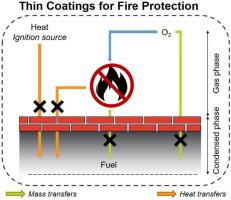Progress in Organic Coatings ( IF 6.5 ) Pub Date : 2021-03-08 , DOI: 10.1016/j.porgcoat.2021.106217 Anne-Lise Davesne , Maude Jimenez , Fabienne Samyn , Serge Bourbigot

|
Catastrophes due to fires cause a lot of material damages and the loss of many human lives. They have been rising in number and severity over the years because of the extensive use of flammable materials such as polymers, which is why it is necessary to design strategies to limit their flammability. Most commercial solutions rely on adding molecules called fire retardant in the bulk of the polymers. On the other hand, concerns regarding the health and environmental hazards of this type of treatments have been growing among both the scientific community and the general public, and regulations were strengthened in response. In this context, fire retardant surface treatments have attracted a lot of the attention recently as they allow to concentrate the fire retardant effect at the interface between the material and the flame, that is, where the combustion process appears. Coatings with thicknesses ranging from the dozens of nanometers to a few micrometers are favored as they limit the amount of material used and limit the impact on the functional properties of the material. This review aims at giving an overview of the different strategies for developing thin coatings for fire protection, with a special emphasis on layer-by-layer surface treatments, which is one of the most promising solutions being developed. One pot strategies as well as several opportunities for new designs are also proposed in order to give some perspectives and new ideas on the development of novel systems.
中文翻译:

防火薄涂层:现有策略的概述,重点放在逐层表面处理和有前途的新解决方案上
火灾造成的灾难造成许多物质损失,并造成许多人的生命损失。多年来,由于大量使用易燃材料(例如聚合物),它们的数量和严重性一直在上升,这就是为什么有必要设计策略来限制其可燃性的原因。大多数商业解决方案都依赖于在大部分聚合物中添加称为阻燃剂的分子。另一方面,在科学界和公众中,人们对这种疗法对健康和环境的危害日益引起关注,并为此加强了法规。在这种情况下,阻燃表面处理近来引起了很多关注,因为它们可以将阻燃效果集中在材料与火焰之间的界面上,也就是说,燃烧过程出现的地方。厚度范围从几十纳米到几微米的涂层是有利的,因为它们限制了所用材料的数量并限制了对材料功能特性的影响。这篇综述旨在概述开发防火薄涂层的不同策略,特别着重于逐层表面处理,这是正在开发的最有希望的解决方案之一。还提出了“一锅策略”以及一些新设计的机会,以便为新型系统的开发提供一些观点和新思路。厚度范围从几十纳米到几微米的涂层是有利的,因为它们限制了所用材料的数量并限制了对材料功能特性的影响。这篇综述旨在概述开发防火薄涂层的不同策略,特别着重于逐层表面处理,这是正在开发的最有希望的解决方案之一。还提出了“一锅策略”以及一些新设计的机会,以便为新型系统的开发提供一些观点和新思路。厚度范围从几十纳米到几微米的涂层是有利的,因为它们限制了所用材料的数量并限制了对材料功能特性的影响。这篇综述旨在概述开发防火薄涂层的不同策略,特别着重于逐层表面处理,这是正在开发的最有希望的解决方案之一。还提出了“一锅策略”以及一些新设计的机会,以便为新型系统的开发提供一些观点和新思路。这是正在开发的最有前途的解决方案之一。还提出了“一锅策略”以及一些新设计的机会,以便为新型系统的开发提供一些观点和新思路。这是正在开发的最有前途的解决方案之一。还提出了“一锅策略”以及一些新设计的机会,以便为新型系统的开发提供一些观点和新思路。











































 京公网安备 11010802027423号
京公网安备 11010802027423号